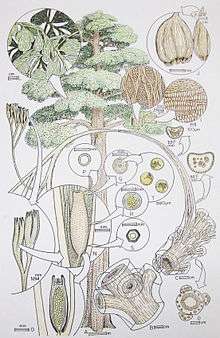Moresnetiaceae
| Moresnetiaceae Temporal range: Devonian–Carboniferous | |
|---|---|
 | |
| A reconstruction of Stamnostoma huttonense from the Early Carboniferous Cementstone Group at Foulden Newton, Berwickshire, England[1] | |
| Scientific classification | |
| Kingdom: | Plantae |
| Phylum: | †Pteridospermophyta |
| Order: | †Lyginopteridales |
| Family: | †Moresnetiaceae |
| genera[2] | |
| |
Moresnetiaceae is a natural family of seed ferns (Pteridospermophyta) in North American and European Devonian to Carboniferous coal measures.[3]
Description
Moresnetiaceae were shrubs to trees with radiospermic ovules with a lagenostome and aggregated into multiovular cupules.
See also
References
- ↑ Retallack, G.J. & Dilcher, D.L (1988). "Reconstructions of selected seed ferns.". Annals of the Missouri Botanical Garden. 75: 1010–1057. doi:10.2307/2399379.
- ↑ Anderson, J.M., Anderson, H.M, & Cleal, C.J. (2007). "Brief history of the gymnosperms: classification, biodiveristy, phytogeography and ecology". Strelitzia. 20: 1–280.
- ↑ Cleal, C.J. & Thomas, B.A. (1995). Palaeozoic palaeobotany of Britain. Chapman and Hall, London. pp. 295 pp.
External links
- "Fossilworks: Lepidopteris". paleodb.org. Retrieved 2016-03-18.
This article is issued from Wikipedia - version of the 8/6/2016. The text is available under the Creative Commons Attribution/Share Alike but additional terms may apply for the media files.